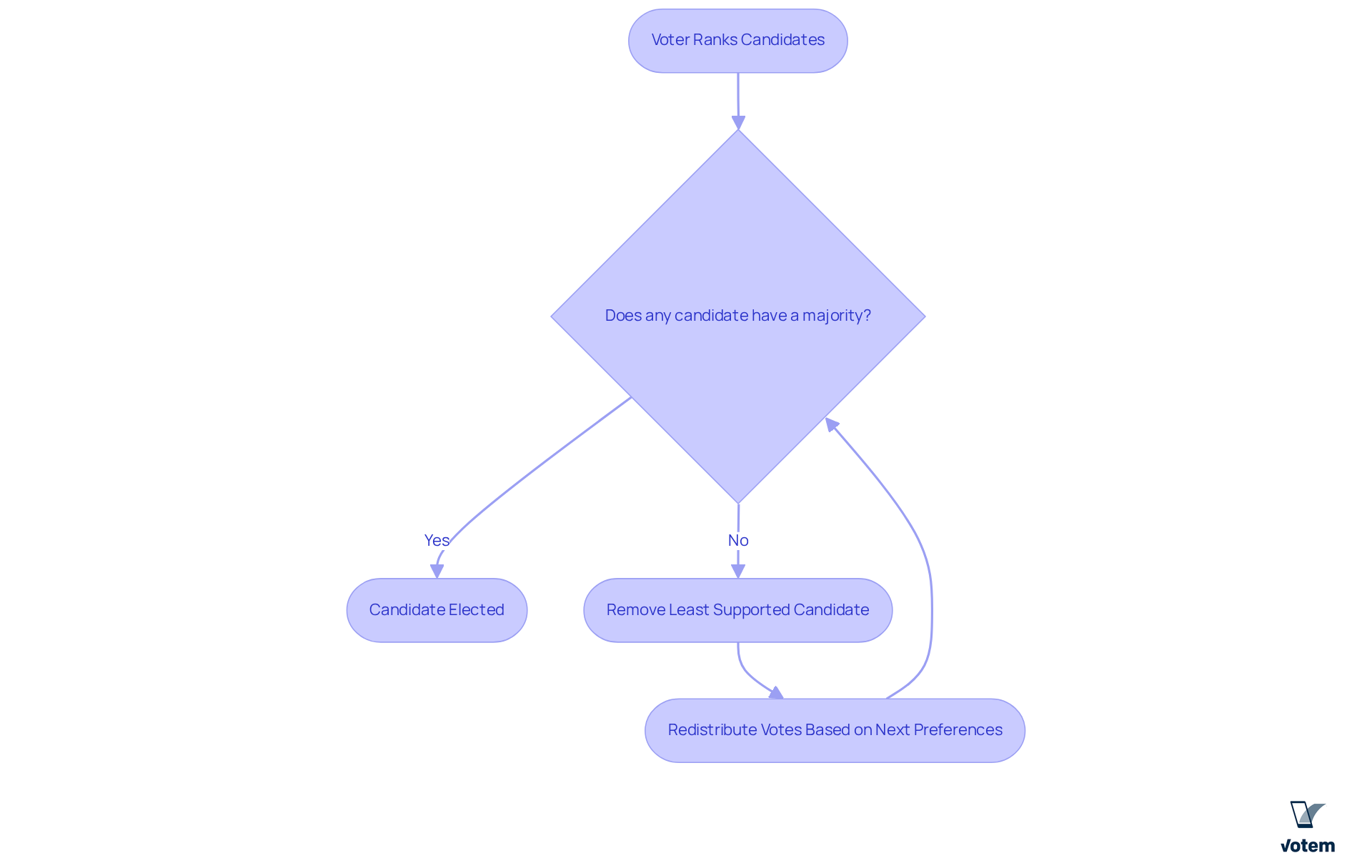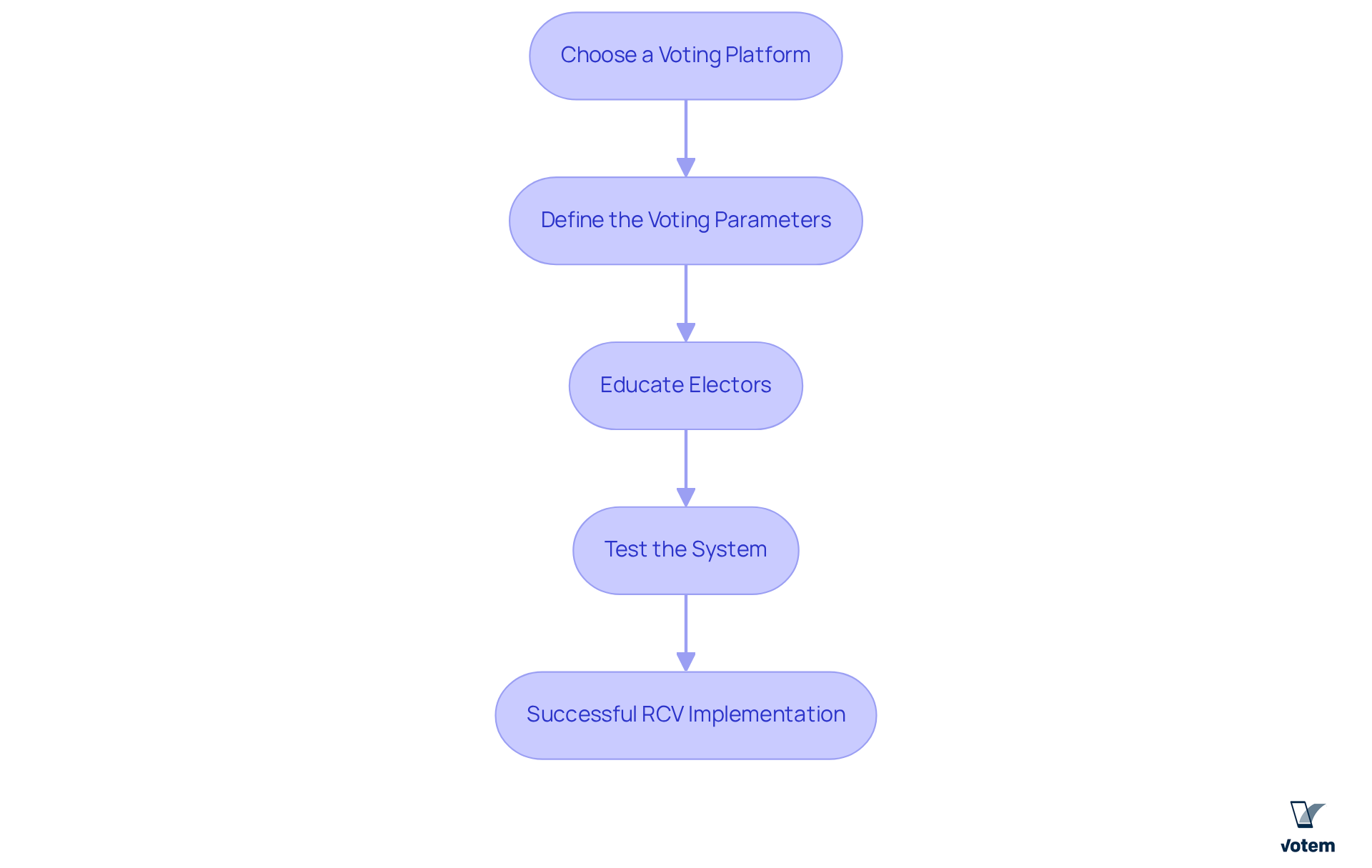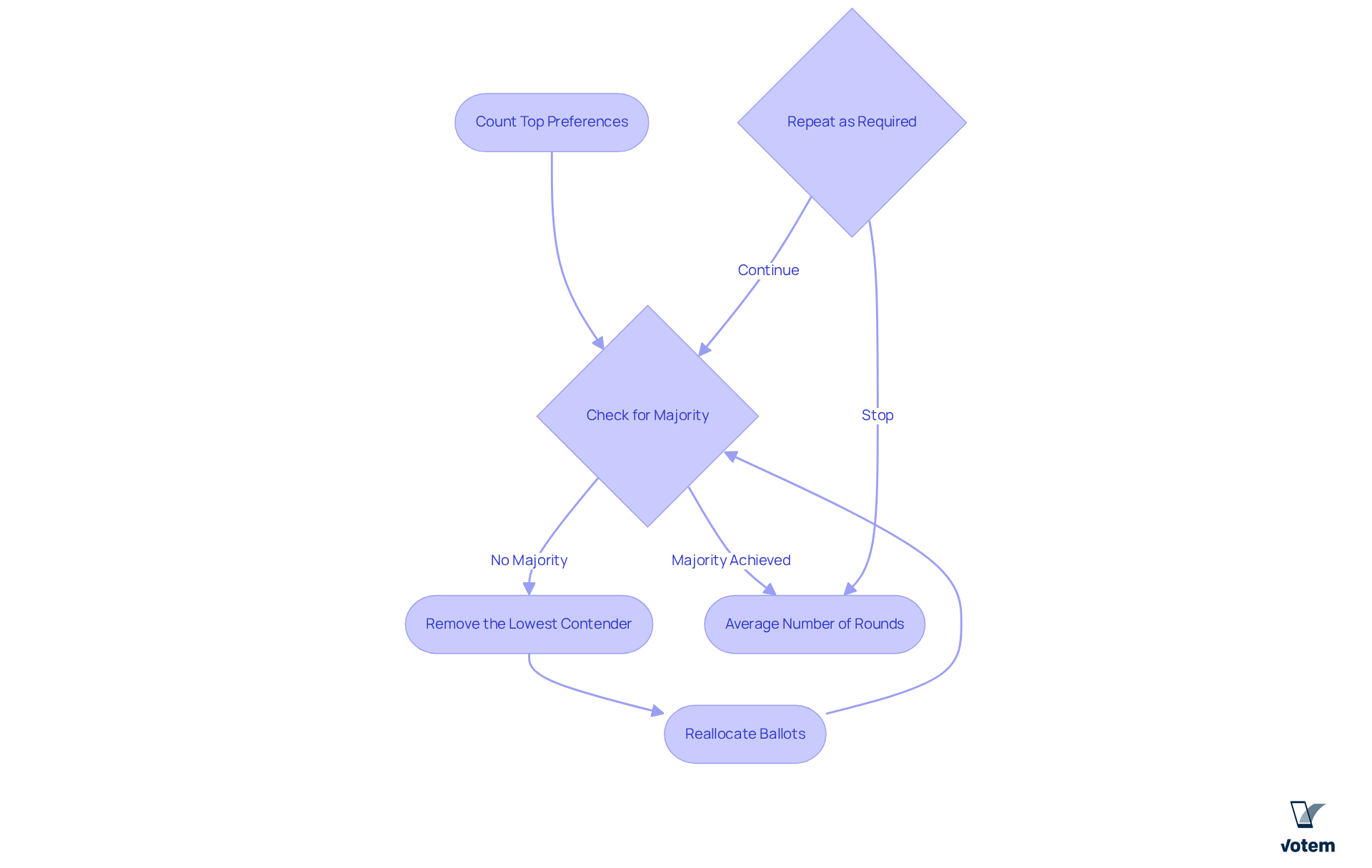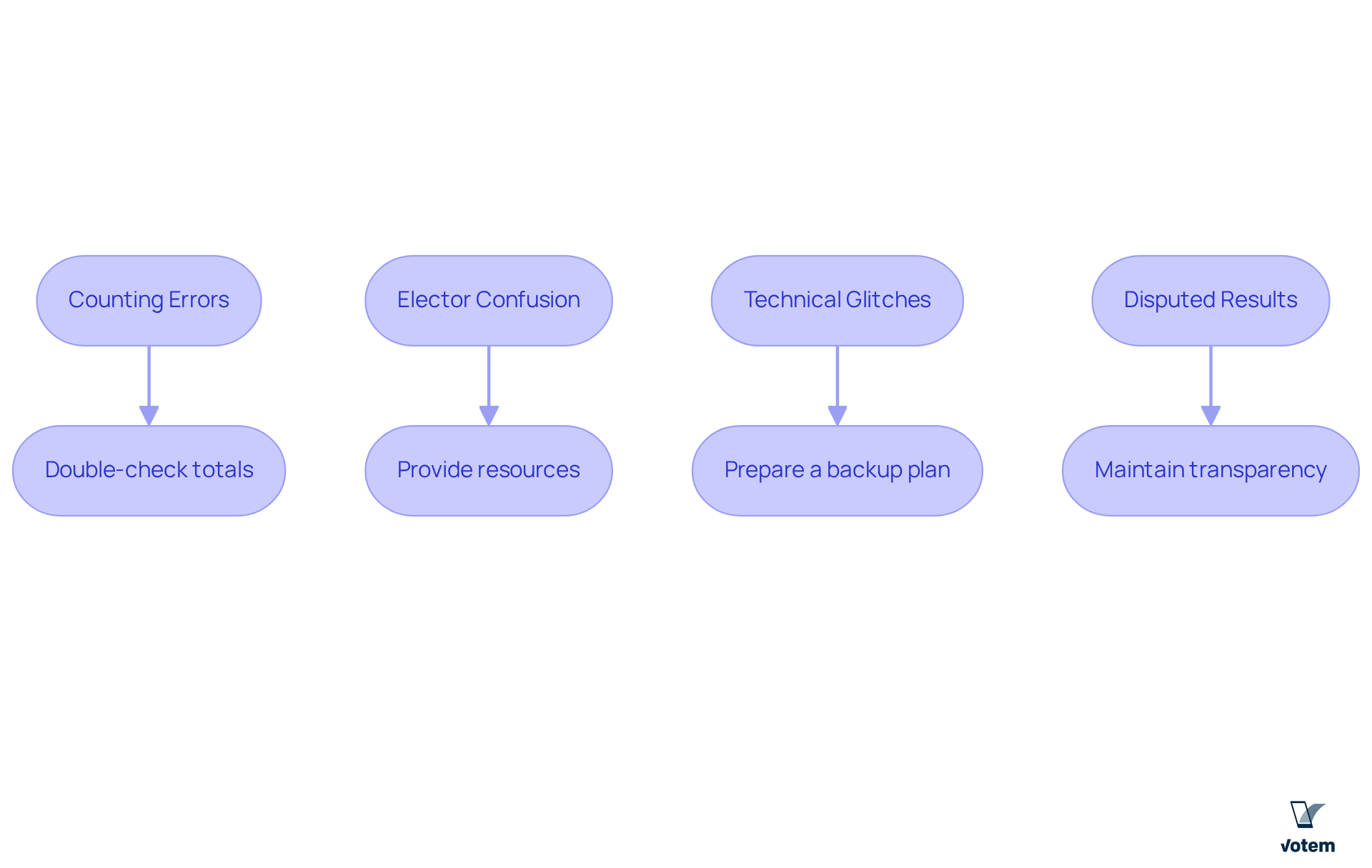Overview
The article serves as a comprehensive step-by-step guide on calculating Ranked Choice Voting (RCV). It details the processes of counting votes, removing candidates, and redistributing ballots until a majority winner is determined. Each phase of the calculation is supported by clear instructions, which emphasize the importance of transparency and accuracy in fostering voter confidence in the electoral process. This guide is essential for union leadership seeking to understand and implement RCV effectively.
Introduction
Ranked Choice Voting (RCV) is fundamentally reshaping the way elections are conducted, allowing voters to express their preferences far more comprehensively than traditional methods. This innovative system not only enhances voter engagement but also significantly reduces the chances of wasted votes and the occurrence of costly runoff elections. However, the complexities involved in calculating votes in RCV can be daunting. How can voters and organizers ensure accuracy and transparency throughout this intricate process?
This guide aims to demystify the step-by-step calculations of RCV, empowering readers with the knowledge necessary to navigate this transformative voting system effectively. By understanding RCV, union leadership can engage their members more meaningfully and advocate for a voting process that reflects the true will of the electorate.
Understand Ranked Choice Voting Basics
Ranked Choice Voting (RCV) is an innovative electoral system that empowers individuals to rank options based on their preferences, rather than selecting just one. In instances where no participant achieves a majority of top-choice selections, the individual with the least support is removed from the competition. Their selections are then reallocated to the remaining contenders according to the voters’ subsequent preferences. This process of removal and redistribution continues until a candidate secures a majority, fostering inclusivity and reducing the likelihood of wasted ballots. Furthermore, RCV eliminates the necessity for costly runoff elections, thereby enhancing the efficiency of the electoral process.
Key terms to know:
- First-choice vote: The candidate a voter ranks highest.
- Majority: Over 50% of the ballots.
- Removal: The procedure of excluding the individual with the fewest ballots from the competition.
- Redistribution: Allocating selections from removed participants to others based on individuals’ subsequent preferences.
The advantages of RCV are substantial. It allows citizens to express their genuine preferences without the fear of wasting their vote. For instance, in New York City, an impressive 83% of participants opted to rank multiple candidates in the initial election utilizing RCV, reflecting strong support for this method. Additionally, RCV has been shown to increase voter turnout by promoting broader participation, ensuring that every vote remains significant throughout the electoral process. Proponents argue that RCV can lead to more civil campaigns, as candidates benefit from being someone’s second or third choice, thereby diminishing negative campaigning. Moreover, 77% of voters expressed a preference for RCV to be adopted in additional elections, indicating robust public backing for this voting system. Overall, RCV represents a transformative approach to voting, fostering a more engaged and representative democratic process. Historically, RCV was first implemented in Ashtabula, Ohio, in 1915, showcasing its long-standing presence in the electoral landscape.

Set Up Your Ranked Choice Voting System
To effectively establish your Ranked Choice Voting (RCV) system, follow these essential steps:
-
Choose a Voting Platform: Begin by selecting a secure online voting platform that is RCV-compatible. For instance, Votem’s CastIron platform ensures compliance with crucial regulations, such as NCUA and DOL, providing a solid foundation for your voting process.
-
Define the Voting Parameters: Clearly outline the number of participants, the voting timeframe, and any specific rules governing the process. This clarity is vital for a smooth operation and helps participants understand what to expect.
-
Educate Electors: Equip individuals with comprehensive instructions and resources to enhance their understanding of how to rank candidates effectively. Consider hosting informational sessions, distributing flyers, and providing online tutorials to facilitate this learning.
-
Test the System: Conduct a trial run of the voting system to identify any potential issues before the actual election. This step is crucial; it ensures that the technology functions correctly and that voters can navigate the process with ease.
By following these steps, union leadership can confidently implement a successful RCV system.

Calculate Votes in Ranked Choice Voting
To calculate votes in a Ranked Choice Voting (RCV) system, follow these steps:
- Count Top Preferences: Begin by counting all first preferences for each contender. This establishes a baseline for the election, providing essential data for understanding how to calculate ranked choice voting in the subsequent steps.
- Check for Majority: Assess whether any nominee has received over 50% of the first-preference choices. If a nominee achieves this threshold, they are declared the winner, ensuring a clear majority.
- Remove the Lowest Contender: If no participant has a majority, identify the individual with the fewest selections and exclude them from the race. This critical step upholds the integrity of the election process.
- Reallocate Ballots: Gather the ballots from the removed contender and redistribute them to the remaining contenders based on voters’ subsequent preferences. Adjust the tally totals accordingly to reflect these changes.
- Repeat as Required: Continue the elimination and redistribution process until a participant secures a majority of support. Document each round of counting to ensure transparency, which is vital for public trust and confidence in how to calculate ranked choice voting in the electoral process.
In RCV contests, the average number of rounds can vary, typically ranging from two to five rounds, depending on the number of candidates and the distribution of votes. Recent developments in RCV counting methods highlight the importance of transparency. Experts emphasize that clear documentation and communication of each step can significantly enhance voter confidence. For example, Sean Dugar, consulting executive director of the California Ranked Choice Voting Coalition, remarked, “In Alameda County, the correct setting should have advanced the second choice to become the first choice.” As demonstrated in various jurisdictions, including New York City, where RCV was implemented in 2021, maintaining an open and transparent counting process is essential for fostering trust in election outcomes.

Troubleshoot Common Calculation Issues
When calculating votes in Ranked Choice Voting, several common issues may arise:
-
It is imperative to ensure that all ballots are accurately counted in each round to understand how to calculate ranked choice voting. Double-checking totals is essential, and utilizing Votem’s innovative online ballot solutions can significantly enhance this process. These solutions have effectively managed large quantities of ballots, reducing human error and improving accuracy. For instance, Votem successfully managed the receipt of 299,000 votes for the National Radio Hall of Fame, which notably increased participation compared to previous years.
-
Elector Confusion: If voters are uncertain about how to rank candidates, it is crucial to provide additional resources or support. Consider hosting Q&A sessions or establishing a hotline for assistance. Votem’s modern system has received commendations for enhancing accessibility for all qualified voters, including military personnel and individuals with disabilities, ensuring that every voter can participate with confidence.
-
Technical Glitches: When utilizing an online platform, it is wise to be prepared for potential technical issues. Votem’s software has a proven track record of reliability, having facilitated over 123,000 votes in a recent poll—more than double the participation from the previous contest in 2015. Nevertheless, having a backup plan, such as a manual counting process, is advisable to ensure that voting can proceed without interruption.
-
Disputed Results: In the event of a dispute regarding the results, maintaining a clear and transparent record of the counting process is essential. This documentation can aid in resolving conflicts and upholding the integrity of the election. Votem’s commitment to transparency and security in the voting process has been recognized by various organizations, reinforcing trust in electoral outcomes.

Conclusion
Ranked Choice Voting (RCV) stands out as a transformative electoral method that prioritizes voter preferences and enhances democratic engagement. By allowing individuals to rank candidates, RCV not only fosters inclusivity but also mitigates the risk of wasted votes. This ultimately streamlines the electoral process and reduces the need for costly runoffs.
Throughout the article, essential steps for implementing and calculating RCV are detailed. These include:
- Choosing a compatible voting platform
- Educating voters
- Conducting transparent counting processes
Key advantages of RCV, such as increased voter turnout and the promotion of civil campaigns, are highlighted alongside practical troubleshooting tips to address common issues that may arise during the voting process.
The significance of adopting Ranked Choice Voting cannot be overstated. As this system gains traction, it presents an opportunity for a more representative and engaged electorate. Embracing RCV not only empowers voters but also sets the stage for a more inclusive and effective democratic process. Encouraging communities to explore and implement RCV can lead to a brighter future for elections, where every voice is heard and valued.
Frequently Asked Questions
What is Ranked Choice Voting (RCV)?
Ranked Choice Voting (RCV) is an electoral system that allows voters to rank candidates based on their preferences instead of selecting just one candidate.
How does RCV work when no candidate receives a majority?
If no candidate achieves a majority of top-choice votes, the candidate with the least support is removed from the competition, and their votes are redistributed to the remaining candidates based on the voters’ next preferences. This process continues until a candidate secures a majority.
What are some key terms associated with RCV?
Key terms include: – First-choice vote: The candidate a voter ranks highest. – Majority: More than 50% of the ballots. – Removal: Excluding the candidate with the fewest votes from the competition. – Redistribution: Allocating votes from removed candidates to others based on voters’ subsequent preferences.
What are the advantages of RCV?
RCV allows voters to express genuine preferences without the fear of wasting their vote, increases voter turnout by encouraging broader participation, and can lead to more civil campaigns. It also eliminates the need for costly runoff elections.
How popular is RCV among voters?
RCV has strong public support, with 83% of participants in New York City opting to rank multiple candidates in the first election using RCV, and 77% of voters expressing a preference for RCV to be used in more elections.
When was RCV first implemented?
RCV was first implemented in Ashtabula, Ohio, in 1915, indicating its long-standing presence in the electoral landscape.
List of Sources
- Understand Ranked Choice Voting Basics
- Measure 117 would bring ranked choice voting to Oregon by 2028 (https://opb.org/article/2024/10/15/think-out-loud-measure-117-oregon-ranked-choice-voting)
- Western voters reject ranked-choice voting – High Country News (https://hcn.org/articles/western-voters-reject-ranked-choice-voting)
- The Impact of Ranked Choice Voting on New Yorkers (https://nycvotes.org/news-and-press/articles/the-impact-of-ranked-choice-voting-on-new-yorkers)
- Ranked choice is ‘the hot reform’ in democracy. Here’s what you should know about it (https://npr.org/2023/12/13/1214199019/ranked-choice-voting-explainer)
- Set Up Your Ranked Choice Voting System
- How to Vote in a Ranked Choice Election (https://charlottesville.gov/CivicAlerts.asp?AID=2176)
- Ranked choice voting is coming to Charlottesville in 2025 (https://vpm.org/news/2024-09-04/ranked-choice-voting-is-coming-to-charlottesville-in-2025)
- County continues preparing, educating with November’s Ranked Choice Voting election on horizon; voters encouraged to practice with virtual sample ballot (https://multco.us/news/county-continues-preparing-educating-novembers-ranked-choice-voting-election-horizon-voters)
- NEWS RELEASE: As Nov. 5 deadline approaches, get familiar with ranked-choice voting; Elections shares ballot basics and a sample results page (https://multco.us/news/news-release-nov-5-deadline-approaches-get-familiar-ranked-choice-voting-elections-shares)
- On the Ballot: Ranked Choice Voting (https://skokie.org/CivicAlerts.asp?AID=1091&ARC=3167)
- Calculate Votes in Ranked Choice Voting
- Ranked Choice Voting (https://ncsl.org/elections-and-campaigns/ranked-choice-voting)
- How Votes are Counted | NYC Votes (https://nycvotes.org/how-to-vote/ranked-choice-voting/how-votes-are-counted)
- Home (https://elections.virginia.gov/casting-a-ballot/ranked-choice-voting)
- Research and data on RCV in practice – FairVote (https://fairvote.org/resources/data-on-rcv)
- Ranked-choice voting (RCV) (https://ballotpedia.org/Ranked-choice_voting_(RCV))
- Troubleshoot Common Calculation Issues
- The impact of voter confusion in ranked choice voting (https://onlinelibrary.wiley.com/doi/10.1111/ssqu.13366)
- Ranked choice voting – SciLine (https://sciline.org/elections/ranked-choice-voting-quotes)
- (https://nyccfb.info/media/reports/voter-analysis-report-2021-2022)
- What We Know About Ranked Choice Voting, Updated for 2025 (https://americanbar.org/groups/public_interest/election_law/american-democracy/our-work/what-we-know-about-ranked-choice-voting-2025)

